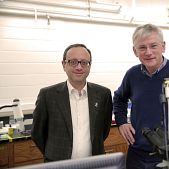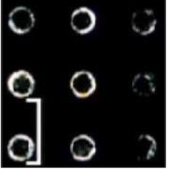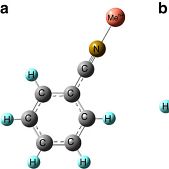
Greek researcher discovered a new method for making chemical sensors
By combining expertise in computational chemistry and liquid crystals, University of Wisconsin-Madison chemical engineers, among them a Greek researcher, have developed a new framework for discovering chemical sensors.
The same principles the researchers used to optimize their material to detect a molecular mimic of deadly sarin gas will also apply to making sensors for other substances like explosives, industrial pollutants, or chemical markers of disease found in a person’s breath. The researchers described the material in the journal Nature Communications.
“We’ve established a new framework,” says Manos Mavrikakis, the Vilas Distinguished Achievement Professor and Paul A. Elfers Professor in chemical and biological engineering at UW-Madison.
That framework is a new approach for optimizing the various components of a liquid-crystal based sensor: metal cations (positively charged ions), salt anions, solvents, and molecules that form liquid crystals—similar to those found in digital displays. The research leveraged Mavrikakis’ computational chemistry expertise and the experimental expertise of collaborator Nicholas L. Abbott, the John T. and Magdalen L. Sobota Professor and Hilldale Professor in chemical and biological engineering at UW-Madison.
The researchers cycled between quantum chemical modeling and laboratory experiments to optimize the sensor components for a targeted substance. By tweaking each of the individual components in turn, they identified an ideal combination that specifically responded to the molecule they wanted to sense, called the analyte.
The same approach could yield novel sensors for a whole host of different analytes.
In the future, for example, such materials could be used to indicate the freshness of fish or meat based on the presence of trace amounts of the foul-smelling molecule cadaverine; another variation might be used to detect respiratory diseases based on analysis of small molecules such as nitric oxide in breath.
Making such specific and sensitive materials in the lab is no easy undertaking. For complicated sensors that involve multiple components, mixing and matching chemicals in the hopes of stumbling across the perfect combination is laborious and inefficient.
Instead of spending years of trial and error, the researchers turned to computer simulations before attempting experiments in the lab.
“This is indeed the first time that computational chemistry with quantum mechanics has been used to put together a coherent way of thinking for narrowing down possible solutions for an explosively complicated problem,” says Mavrikakis.
And after identifying promising candidates, the researchers used real-world measurements to further refine and improve their computational models.
The material consists of a thin film of metal salt, with liquid crystals anchored to the surface all pointing in the same direction. The researchers designed specific liquid crystal molecules and metal cations so that small amounts of analyte disrupted the interactions of the liquid crystals with the surface and threw the ordered arrangement into disarray. That, in turn, generated an optical signal.
Unlike expensive explosive-detecting puffer machines in airports that rely on complicated mass spectrometry or high-performance liquid chromatography equipment, these types sensing materials could create sensors that are portable or wearable and inexpensive to make.
Moving forward, the researchers plan to explore new combinations for additional analytes and develop new liquid crystalline molecules, in combination with other metal salts and solvents, to make even more sensitive and selective sensors.
Other authors on the paper included Luke Roling, Jessica Scaranto, Jeffrey Herron, Huaizhe Yu, and Sangwook Choi. The National Science Foundation and the Army Research Office supported the research.
Read also:










